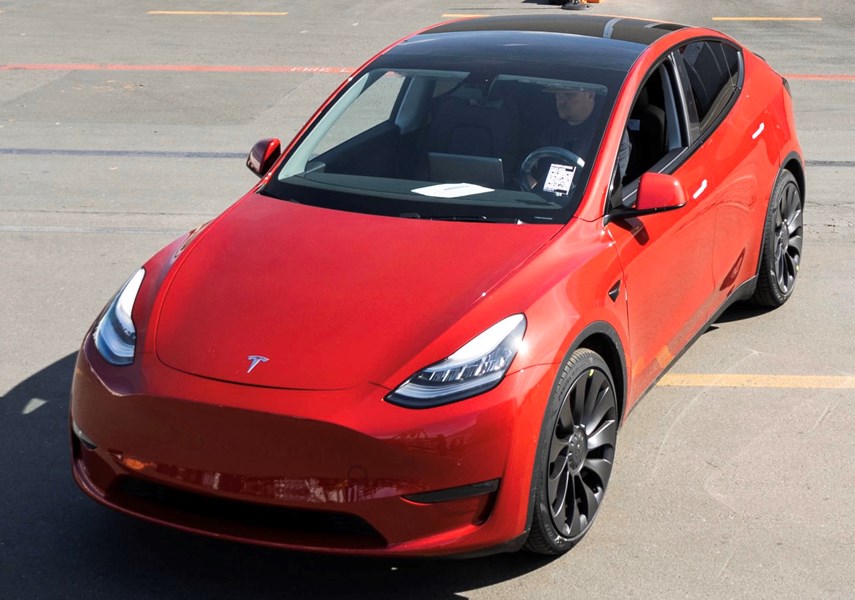A biweekly roundup of automotive news, good, bad and just plain weird:
Tesla builds its one millionth vehicle
As a milestone of how far the company has come, Tesla this week announced the production of its one millionth electric vehicle. The EV in question is a red 2020 Model Y crossover, spec’d out in Performance trim with 21-inch wheels and a few other goodies.
As ever, the announcement was greeted with the usual mix of skepticism and fanfare that accompanies any Tesla broadcast. On one hand, the team of workers that produced this latest machine are to be commended for hitting a major production landmark. On the other hand, Tesla’s financials are still convoluted enough to show that production figures are no indication of long-term viability.
Still, the millionth Tesla milestone provides increased confidence that the Model Y crossover, slated to be the automaker’s first entry in the compact-luxury SUV segment, is on target to begin deliveries this year. The first vehicles out of the factory will be the higher-margin Performance and Long-Range variants. A similarly equipped Model Y to the one shown will cost $86,990 before delivery, or closer to a six-figure price tag if you order the optional $9,200 driver-assist upgrade to Tesla’s Autopilot system.
Mercedes-Benz might bring electric vans to North America
Sold as the Vito in European markets, the Mercedes-Benz Metris is the Sprinter’s little brother, ideally sized for smaller deliveries. To work better in zero-emissions zones in Europe, M-B is offering their Metris as a pure-electric van, as well as diesel and gasoline offerings for longer haul transport.
Currently, the Metris is only available in gasoline-powered form on this side of the water, but Mercedes says it’s considering the business case for the EV variant. While a battery powered Metris would be costly – still the major drawback of EVs – offering emissions-free delivery would be welcome advertising for some companies.
Further, the Metris is a usefully sized vehicle, neither too big nor too small. As plug-in vehicles become more common, the first manufacturer to market with a workable EV van solution will benefit by selling to companies that are waiting for them.
Tiny Toyota Yaris GR costs as much as a Subaru STI
One vehicle we’re very unlikely to see outside of Europe is the Yaris GR. Based on Toyota’s smallest compact car offering, the two-door Yaris GR is actually a rally car for the road, in the tradition of the Subaru STI, or the now-defunct Mitsubishi Lancer EVO.
Essentially, this little all-wheel-drive pocket rocket is the road-going version of the rally cars that Toyota’s racing team fields in World Rally Championship action. And it’s very potent: a 1.6-litre turbocharged three-cyclinder engine produces 268 horsepower (the same output as the current Subaru WRX), and there’s all-wheel drive with limited-slip differentials front and rear.
The cost for all this go-fast tech isn’t cheap, with the top of the range Yaris GR costing just under $60,000 in Canadian money. That’s a lot, especially when there are already cars like the Veloster N, Civic Type R, or, yes, the Subaru WRX available for much less.
Perhaps adjusted for the market pricing, the Yaris GR would make a lot more sense. Either way, it’s still pretty tempting to have that much power in such a small package.
Koenigsegg launches 1,700 h.p. Gemera hybrid
Speaking of three-cylinder engines, the new Koenigsegg supercar is out, and its spec sheet reads like the Swedish company is just making things up. The Gemera is a four-seater coupe with doors that swing straight up, a 2.0-litre three-cylinder engine that makes 600 h.p. and doesn’t have any camshafts, and 1,100 h.p. worth of electric motors to fill out the gap. It’ll sprint to 100 kilometres per hour in 1.9 seconds.
The engine, which Koenigsegg calls the TFG, for Tiny Friendly Giant, is about 20 per cent more efficient than a conventional engine of the same displacement. The company’s Freevalve system offers total control over the exhaust and intake valves, helping keep emissions low. It’ll also run on renewable alcohol, and the whole engine fits in a carry-on suitcase.
While this is all supercar stuff, and not really applicable to anything you might see on the street on a regular basis, the idea of sustainable supercars is becoming less of an oxymoron than it used to be. It’s not the consumption that people are paying for with a Koenigsegg, it’s the technology.
Coronavirus delays launch of Cadillac Lyriq
Cadillac’s new Ultium platform is going to underpin a host of new battery-powered vehicles, as the company looks to get a foothold in the new era of luxury EVs. Unfortunately, 2020 is also the era of a scary new pandemic, and that means that the just-announced Lyriq crossover is already getting pushed back.
The Lyriq was set for its debut on April 2 of this year, but GM has delayed that launch, with no word as to when the rescheduled launch might occur. This move comes after the Geneva International Motor Show was cancelled outright, and the New York International Auto Show was moved to August.
Launches aren’t the only thing that COVID-19 is disrupting in the automotive industry. With supplier networks vulnerable to quarantines and shipping shutdowns, manufacturers are struggling to stay on target.
The Lyriq won’t be the first delay we’ll see caused by coronavirus. But better to be cautious in these times, even when gambling on an all-electric future.
Watch this space for all the week’s best and worst of automotive news, or submit your own auto oddities to [email protected].
Ìý



